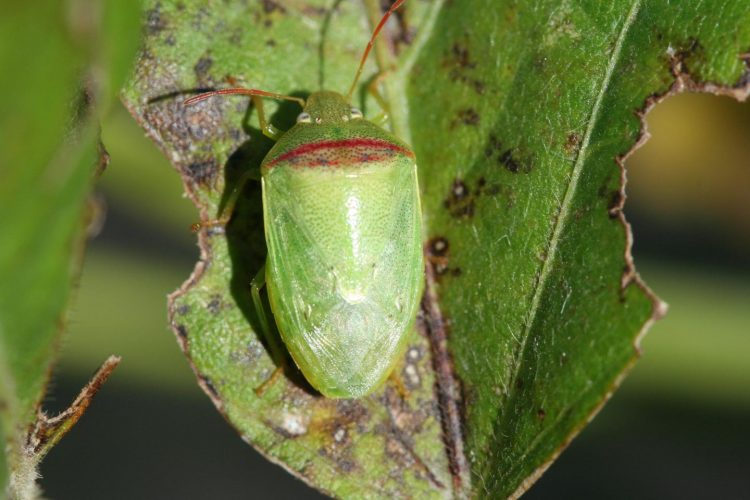Entomologists sniff out new stink bug to help soybean farmers control damage

This image shows a redbanded stink bug. Photo courtesy of Dr. Mo Way, Texas A&M AgriLife Research-Beaumont
Various types of stink bugs have long been a problem on soybean crops, but when sweeps of fields in southeast Texas netted 65 percent redbanded stink bugs, entomologists realized this particular bug had become the predominant pest problem, according to Dr. Mo Way, an entomologist at the Texas A&M AgriLife Research and Extension Center in Beaumont.
The problem was no one in the U.S. knew much about the redbanded stink bug and how it had been able to overcome the previously predominant southern green stink bug, green stink bug and brown stink bug, Way said. An insect's life cycle and biology have to be understood before scientists can figure out ways to control it.
Texas farmers plant a little less than 200,000 acres of soybeans a year, according to the U.S. Department of Agriculture's National Agricultural Statistics Service.
“The redbanded stink bug has been a serious pest of soybeans in South America since the 1960s,” said Dr. Suhas Vyavhare, a postdoc at the Beaumont center who began his work on the insect as a graduate student there. “It was never a problem in the United States until around 2000. Prior to that, it was known to be in the soybean fields, but that's when it was first reported in Louisiana as being an economic pest.”
Not only did the research team find insect numbers at economically damaging levels in Texas but also determined that the redbanded stink bug was becoming resistant to the organophosphate chemical that previously had provided effective control, said Vyavhare, who collaborated with Way and AgriLife Research entomologist Dr. Raul Medina in College Station.
“We started by looking at population dynamics, or how abundant redbanded stink bug is in Texas,” Vyavhare said. “We did sweep net surveys across various commercial soybean fields in southeast Texas. We also looked at insect-plant interaction in order to determine what soybean growth stages are most susceptible to redbanded stink bug damage so we could target pest management practices.”
He said the researchers also had an inkling the redbanded stink bug was responsible for what is known as delayed maturity syndrome in which the soybean plant does not grow at its normal rate. They tested this theory by subjecting a controlled growth of soybeans to different densities of redbanded stink bugs and found that the insect is directly connected to the disorder.
“There are more than 50 species of stink bugs found in soybeans. Some of them are beneficial and some are pests,” Vyavhare said. “The redbanded stink bug as compared to the other pest stink bugs is smaller, and it has the ability to fly faster. So it is very agile, and that contributes to its movement into different areas, and it could be one of the reasons why it is not that susceptible to insecticides because when a farmer sprays the field, they could be escaping before the chemical reaches them.”
Finding that the insect is becoming resistant to the common insecticide used as well as the fact that more frequent doses were required to control them was a significant point in the research, Vyavhare said.
“Now we are recommending that farmers use different products rather than the same one over and over,” he said. “So that could reduce the amount of insecticide that is applied. Even if we can reduce the need for one insecticide application, that could save millions of dollars in Texas and the other infected states each year.”
The team is also hoping to continue research with other control possibilities such as using a trap crop planted near soybeans to attract the insects away or developing redbanded stink bug-resistant soybean varieties.
Way said the team also is revising a soybean pest management guide last published in 1999 so farmers will know steps that can be taken to reduce crop damage from the redbanded stink bug.
Media Contact
All latest news from the category: Agricultural and Forestry Science
Newest articles

NASA: Mystery of life’s handedness deepens
The mystery of why life uses molecules with specific orientations has deepened with a NASA-funded discovery that RNA — a key molecule thought to have potentially held the instructions for…

What are the effects of historic lithium mining on water quality?
Study reveals low levels of common contaminants but high levels of other elements in waters associated with an abandoned lithium mine. Lithium ore and mining waste from a historic lithium…

Quantum-inspired design boosts efficiency of heat-to-electricity conversion
Rice engineers take unconventional route to improving thermophotovoltaic systems. Researchers at Rice University have found a new way to improve a key element of thermophotovoltaic (TPV) systems, which convert heat…



